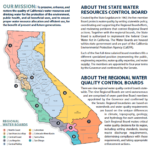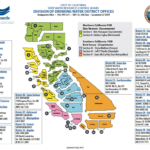State Water Resources Control Board
The State Water Resources Control Board is the agency that regulates water quality, allocates surface water rights, and regulates drinking water systems.
The mission of the State Water Board is to preserve, enhance, and restore the quality of California’s water resources and drinking water for the protection of the environment, public health, and all beneficial uses, and to ensure proper water resource allocation and efficient use, for the benefit of present and future generations.
The State Water Board has four divisions:
- Division of Water Quality: Under the federal Clean Water Act (CWA) and the state’s Porter-Cologne Water Quality Control Act, the State and Regional Water Boards have regulatory responsibility for protecting the water quality of nearly 1.6 million acres of lakes, 1.3 million acres of bays and estuaries, 211,000 miles of rivers and streams, and about 1,100 miles of exquisite California coastline. The Water Boards regulate wastewater discharges to surface water (rivers, ocean, etc.) and to groundwater (via land). The Water Boards also regulate storm water discharges from construction, industrial, and municipal activities; discharges from irrigated agriculture; dredge and fill activities; the alteration of any federal water body under the 401 certification program; and several other activities with practices that could degrade water quality. View all water quality programs here.
- Division of Water Rights: The State Water Board’s Division of Water Rights administers California’s water right system. This includes issuing permits and licenses, compliance monitoring, and enforcement. View all water rights programs here.
- Division of Drinking Water: The Division of Drinking Water (DDW) regulates public drinking water systems. Regulatory oversight of the state’s public water system is provided by Field Operations Branches, who perform field inspections, issue operating permits, review plans and specifications for new facilities, take enforcement actions for non-compliance with laws and regulations, review water quality monitoring results, and support and promote water system security. In addition, Field Operations Branch staff are involved in funding infrastructure improvements, conducting source water assessments, evaluating projects utilizing recycled treated wastewater, and promoting and assisting public water systems in drought preparation and water conservation. More information here.
- Division of Financial Assistance: The Division of Financial Assistance administers the implementation of the Board’s financial assistance programs, including loan and grant funding for construction of municipal sewage and water recycling facilities, remediation for underground storage tank releases, watershed protection projects, and nonpoint source pollution control projects. Click here for more information.
Governance and structure:
The Water Board is governed by five full-time salaried members, each with a different specialty. Each board member is appointed to a four-year term by the Governor and confirmed by the Senate. Here's who is currently serving on the State Water Board.
There are nine Regional Water Quality Control Boards. The mission of the Regional Boards is to develop and enforce water quality objectives and implementation plans that will best protect the beneficial uses of the State’s waters, recognizing local differences in climate, topography, geology and hydrology. Each Regional Board has seven part-time Members also appointed by the Governor and confirmed by the Senate. Regional Boards develop “basin plans” for their hydrologic areas, govern requirements/issue waste discharge permits, take enforcement action against violators, and monitor water quality. Click here for a fact sheet on the regional water boards.
Click here for coverage of the State Water Resources Control Board on Maven's Notebook.



